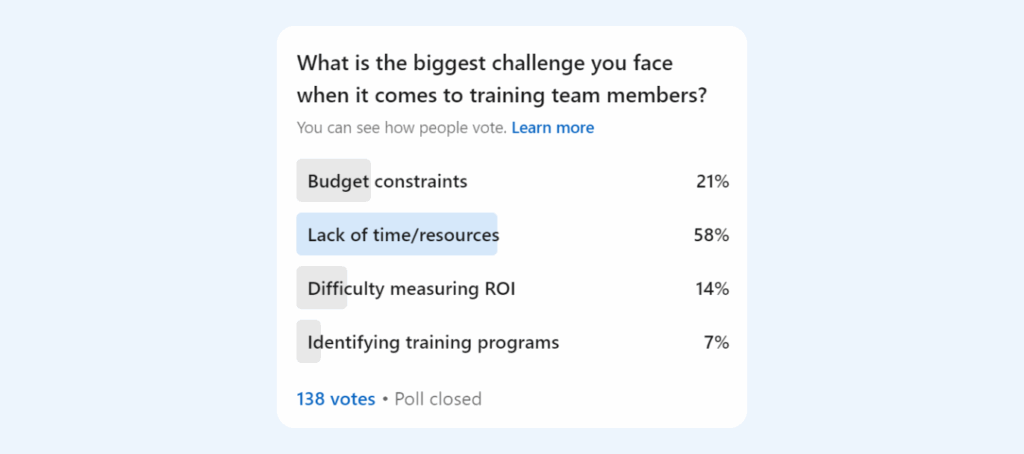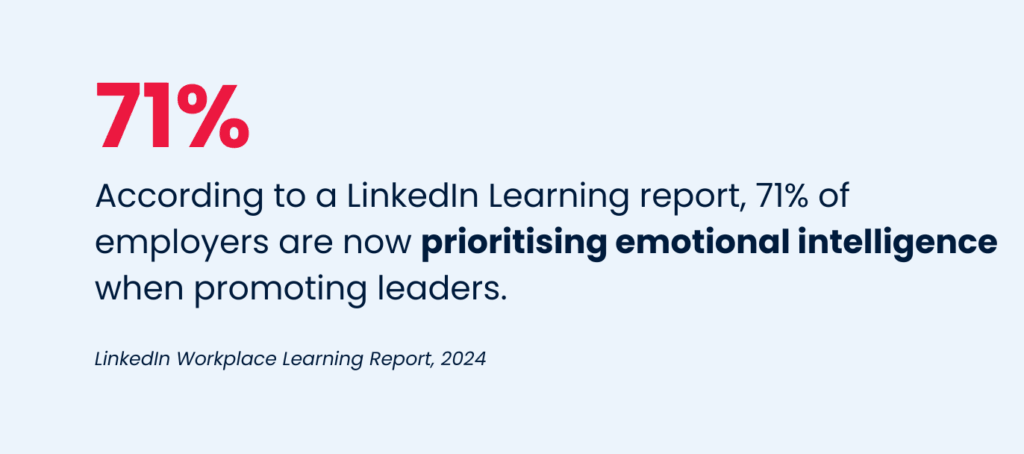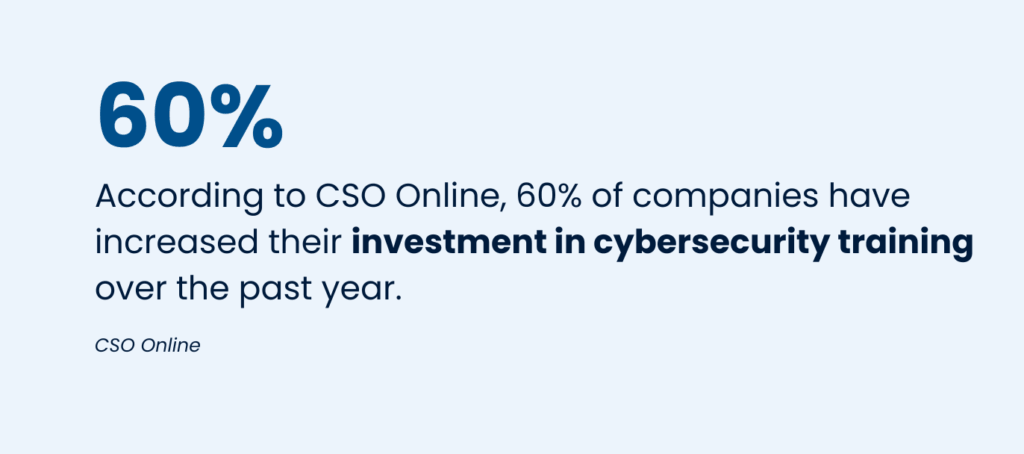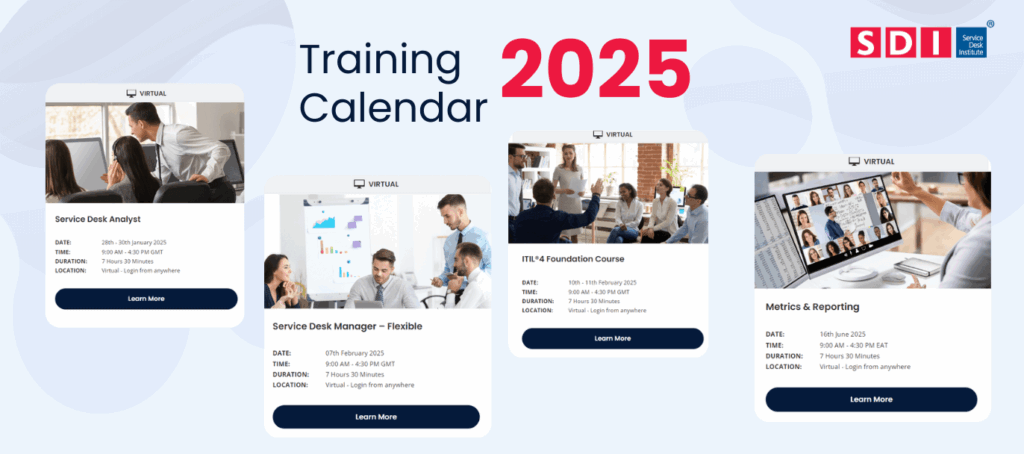 Back to Resources
Back to Resources
Effective employee training isn’t just a nice-to-have — it’s essential. Especially today when many companies strive to keep up with new technological advancements. Employees must keep learning to use the latest tools and technologies to improve service delivery. To do so, they need the right skills to stay efficient and keep up with all those changes.
Investing in training and people also shows you’re committed to their growth. A well-trained team is more confident, productive, and ready to deliver exceptional results.
But it’s not just about skills, is it?
It’s also about meeting industry standards, staying compliant, and creating a workplace that values diversity and inclusion. When everyone feels supported and equipped, collaboration flourishes, and so does your organisation.
But there are some common challenges companies face when training their employees. Understanding these challenges is the first step toward creating an effective learning and development strategy.
So, in this article we’ll explore:
➡️ How do we overcome common training challenges?
➡️ Tips for creating an effective training strategy.
➡️ What are some trends in employee training?
How to overcome employee training challenges

Let’s look at some common training challenges you might face and how to overcome them.
#1 Lack of time
Based on our research, 58% of respondents stated that lack of time is one of the company’s biggest challenges in training and development. Time is one of the most valuable yet scarce resources. With tight deadlines, constant troubleshooting, and the pressure to deliver innovative solutions, finding time for training and development often feels impossible.
⚡ How to overcome this challenge
The real challenge lies in balancing immediate demands with the long-term need for growth.
Solutions? One method some SDI Members find useful is booking multiple training courses online in one go, reducing a lot of admin time and back and forth organising who can attend when. They then share the dates they have booked with their teams who choose the dates that work best for them. Don’t worry, if you book a date that none can attend the SDI team will gladly swap the dates onto the next available training course. Another method is to explore Bespoke In house Training Options.
Effective time management or careful planning of when and how training sessions are held to maintain productivity while ensuring employees acquire necessary skills. You can try different training methods, such as microlearning, combining online and in-person learning, or planning training sessions during off-peak hours.
#2 Cost of training
Another significant challenge is budget constraints or the cost of training. Specialised skills often require expensive courses, certifications, or event tools. On the other hand, budgets are usually already stretched thin across infrastructure, security, and innovation, making it challenging to allocate resources for employee development.
⚡ How to overcome this challenge
Organisations can explore cost-effective options like online learning platforms, personalised in-house training, government grants and subsidies, and cross-training employees to share knowledge.
#3 Employee Engagement
Introducing training programmes can sometimes spur employee resistance, especially when communication and training are inadequate. In many cases, employees are already balancing busy schedules and tight deadlines, which can also lead to burnout, so they might already feel disconnected and unmotivated.
⚡ How to overcome this challenge
To tackle this, create a workplace culture that values growth and collaboration. You can do this by regularly offering training opportunities, celebrating employee achievements, and providing clear career paths that can boost morale. You can also try interactive modules like videos, quizzes, or real-life scenarios to make training more engaging or gamification.
But most importantly, don’t forget to talk to your employees and get their feedback.
#4 Skill Retention
In the IT industry, where rapid technological advancements and evolving tools often lead to a “use it or lose it” scenario, skill retention can be another training challenge. Employees may learn new skills during training but struggle to retain them if they aren’t applied regularly, which can result in wasted resources.
⚡ How to overcome this challenge
To overcome this challenge, consider strategies that can improve memory retention. You can offer regular refresher courses and hands-on opportunities to practise new skills, encourage knowledge sharing through mentoring or collaborative projects, or provide post-training support.
#5 Difficulty measuring ROI
Measuring ROI for training in the IT environment can be tricky. The impact of skills development isn’t always easy to quantify, especially when dealing with intangible benefits like improved problem-solving or enhanced teamwork. That’s why many organisations struggle to link training directly to performance metrics, leaving decision-makers questioning its value.
⚡ How to overcome this challenge
To overcome this, it’s essential to set clear goals for training programmes. This can include goals such as boosting productivity, reducing downtime, or enhancing project outcomes. To understand the impact of training, you can do post-training evaluations using metrics like employee performance reviews, certification completions, and time saved on tasks.
Here’s how to build an effective training plan
To navigate these challenges mentioned above and enhance your team’s capabilities, consider implementing some of the following steps:
Before you start developing your training strategy, identify your team’s current skills and competencies. Evaluate your team’s existing skills to understand their strengths and areas for improvement. But don’t forget to think about future needs. Consider the skills required to meet upcoming projects and industry trends and ensure they align with organisational goals.
The next thing you should do is define clear and measurable objectives. Consider objectives for your training programmes, such as mastering a particular tool or enhancing customer service skills. Ensure that training goals support broader organisational objectives, facilitating measurable performance improvements.
Another good tip is to embrace blended learning. Combine online courses, in-person workshops, and hands-on practice to cater to diverse learning preferences and enhance engagement. You can utilise e-learning platforms and virtual simulations to provide flexible and scalable training solutions.
Foster a culture of continuous learning and promote an environment where ongoing education is valued, motivating employees to pursue personal and professional development.
Lastly, remember to implement evaluation mechanisms to monitor progress regularly. Don’t ignore the post-training support for coaching, and always be prepared to refine your training approach based on evaluation outcomes.
What Learning Trends We Can Expect in 2025
#1 AI-Driven Learning Experiences
One of the most prominent shifts is AI-driven learning experiences, which personalise content based on employee data, making training more relevant and engaging. AI-powered learning assistants are also streamlining the learning process, offering on-demand support and guidance.
So, in 2025, expect more AI-driven platforms that tailor learning paths to individual needs.
#2 Prioritising Emotional Intelligence Skills

As AI and automation increasingly take over technical tasks, emotional intelligence (EQ) is becoming a key focus. Companies recognise that soft skills like communication, empathy, and leadership are vital to effective collaboration and job satisfaction.
Training programmes now prioritise EQ development, ensuring teams work cohesively and resolve conflicts efficiently.
#3 Developing Specific Skills
Skills-based talent management is also gaining traction, moving away from traditional role-based training. Organisations are now focusing on developing specific skills, enabling employees to be more versatile and better equipped to handle future job demands.
This approach also ensures that employees can take on roles as their skills evolve, creating a more agile workforce.
#4 Hybrid learning models
Hybrid learning models are transforming how training is delivered, blending online and in-person learning to cater to diverse learning preferences. This flexibility not only helps employees learn at their own pace but also ensures that training remains accessible to remote teams.
#5 Increased Focus on Cybersecurity Training

As cyber threats continue to increase, cybersecurity training is becoming more crucial. In 2025, expect more emphasis on proactive threat management in training programmes. This shift comes in response to the rising number of security breaches and data leaks.
For ITSM professionals, staying ahead of these threats through continuous education is key to protecting their organisation and its clients.
#6 Integrating Learning with Employee Experience
Lastly, integrating learning into the broader employee experience is gaining importance. Learning is no longer seen as a separate function but is now embedded into the daily work routine, aligning with employees’ career paths and growth opportunities.
This holistic approach ensures that learning is relevant, continuous, and aligned with the employee journey.
Explore Our 2025 Training Calendar
To support your team’s development in line with these trends, we offer a comprehensive range of training courses designed to meet the evolving needs of ITSM professionals. Explore our 2025 training calendar ➡️ HERE.
By proactively addressing these challenges and integrating emerging learning trends into your training strategy, you’ll be well-equipped to lead your team through the dynamic ITSM landscape in 2025 and beyond.





















